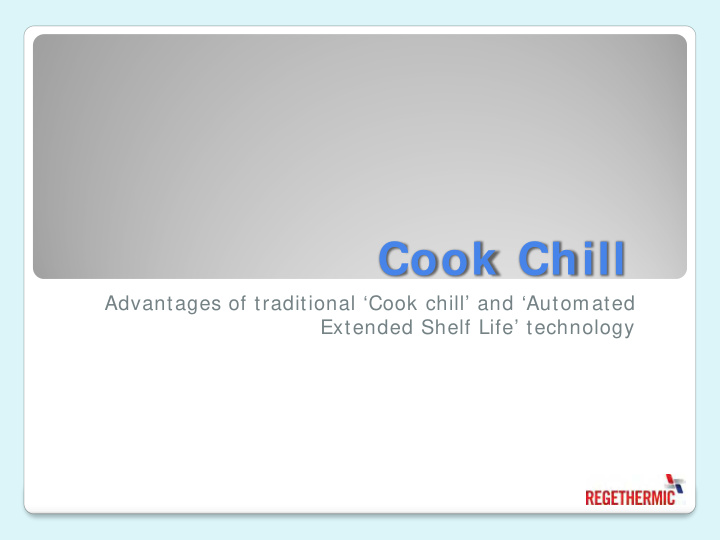



Cook Chill Advantages of traditional ‘Cook chill’ and ‘Automated Extended Shelf Life’ technology
Cook chill is a catering system that is based on cooking food till it is just done followed by rapid blast chilling that reduces the food temperature to below 3 ⁰ C within 90 minutes. Storage at this temperature extends the shelf life of the product to 5 days Cook Chill
Advantages of traditional cook chill Labour cost savings Menu variety Efficient time utilisation Improve nutritional/ bacteriology Increased productivity Improved food quality Economies of scale Quality control Power saving Centralised preparation Economies of raw materials Centralised control
The utilisation of automated extended shelf life technology will reduce a number of process steps and in turn allow for greater efficiencies in labour and distribution. Product shelf life can be increased to between 14 and 30 days Extended shelf life technology
Advantages of autom ated extended shelf life technology Further reduction in labour input Menu versatility at serving location through automation Microbiological safety Improved workplace health and Generally no preservatives safety in the kitchen Reduced weight in transportation Food is cooked in own juices Reduced frequency of delivery Seals in aroma, flavour and nutrients Increased product shelf life Reduced moisture losses Minimal thermal processes Increased shelf life Marketing and economical benefits
Receiving of raw products Dry goods inwards Chilled goods inwards Cooling vegetables 3°C Red meat freezer -18°C Poultry refrigerator 3°C Poultry freezer -18°C Red meat refrigerator 3°C Fish freezer -18°C Thawing (defrost) Dry goods Vegetable below 8°C sanitation Vegetable Fresh meat defrosted meat Recipe room preparation preparation prep batch holding of 10°C to 16°C all dry products 18°C 10°C to 16°C prior to heat treatment Dairy 3°C Batch holding of all raw Small goods 3°C processed food prior to heat Dry To slicing room Bakery dry goods treatment + °C vegetables
Cooking Recipe room 1 8 ° C Batch holding room 3 ° C All dry goods are weighed and labelled All raw products are weighed and on trolleys ready for production labelled on trolleys ready for production Production kitchens Bakery 1 8 ° C Core production Special needs kitchen Production of all hot m eals 18 ° C 1 8 ° C Preparation and portioning of all bakery items. Cooking of All preparation will be taken from the This kitchen will cater for product is shared with core recipe room and the batch holding room. special diet meals or meals production until a secondary Trolleys will be labelled according to the of certain ethnicity. This shift is initiated. The bakery meal to be produced and married together kitchen could also be able will require its own on the production floor. Equipment has accommodate production of equipment space for ovens, been chosen for its throughput capability meals for school children chillers and freezers and versatility Centralized one w ay w ash-up Garbage Garbage removal removal Com pletion of cooking and the beginning of chilling HI GH RI SK
Chilling Blast chilling -1 5 ° C Tum ble chilling Blast freezing - 3 5 ° C Static chilling 1 ° C to 3 ° C 1 ° C to 3 ° C All liquid items pumped All solid items in All solid items in casings into casings 1/ 1 Gastronome pans Stored in Stored on trolleys Swing bar crates Dry store Small snacks and sashes, beverages, Bulk chilled storage 3°C crockery and equipment Portioning Starters/ Salads 10°C Sandwiches 10°C Cooked dishes 10°C Semi finished food 18°C Soups 10°C Bakery 18°C Complete meals 10°C
Packaging Personal m eals Trays packaging Packaging 1 0 ° C 1 0 ° C Vegetables Cooked Packaged Meals in Sandwiches Raw semi and salads portioned and homogeneous recyclable finished fruit packaged packaged meals soups crockery and ved Pasta salads Cooked Packaged Meals in Packaged Cooked semi packaged souse heterogeneous reusable sandwiches finished food dishes soups crockery Meat, poultry and fish Cooked semi finished vegetable etc Semi finished deli snacks Sm all snacks Beverages and sashes
Delivery W aiting for delivery 3 ° C Organise m eals for delivery 3 ° C Cold food delivery room 3 ° C Dispatch to receiving cam pus Bulk Oven DS-ONE Hostess Trolleys
Liquids processing Solids processing Cook tank used for Production kettles sous vide cooking 40 to 400 litre Vegetables and meat Product can also in bags homogenised in kettles Wet product is pumped at 85°C using a pump station. Product placed in cook Soups, sauces, casseroles, tank for overnight cook rice and pasta Overnight cook Hot bags are automatically changes heat sealed to chill cycle ready for at 84°C morning shift
Liquids processing Solids processing Thermal processing complete – Beginning of chilling – HIGH RISK Product transferred to Product in bags placed Blast chillers in Tumble Chiller for Before being moved to rapid chilling freezer for storage Bulk Chilled Storage Bags and casings in swing bar crates/ Dishes on trolleys Portioning Pre or Post delivery Delivery and storage at 3deg C Bulk or Plated Rethermalisation & Distribution
Meal distribution Conveyor plating and line Pre-plated hot and cold meals loaded into DS-ONE tray trolley DS-ONE tray trollies docked ready for rethermalisation prior to meal delivery Meals distributed with Hostess trollies
Click play to view our Virtual extended shelf life dem onstration Click play to view a video of a Blanco Tray line and DS-ONE trolley system in action You tube video links For printed versions of this presentation these videos and others can be found on our Youtube channel at www.youtube.com/ user/ RegethermicAustralia
Recommend
More recommend